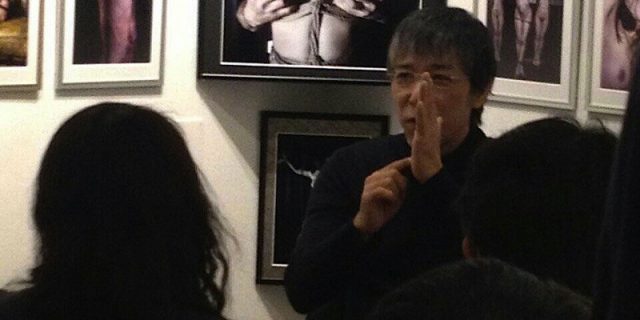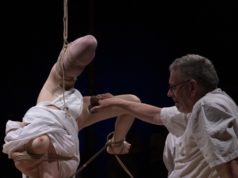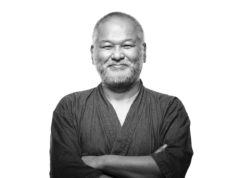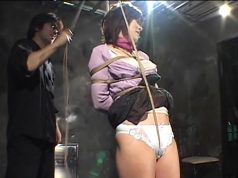 Shigonawabingo san co-runs the traditional Japanese rope-play bars -UBU- and -mitsu- in Shinjuku-ku, Tokyo with Yoi Yoshida san, and teaches not only theory and practice, but also the etiquette and philosophy of Kinbaku. He is a friendly and encouraging individual who has taken traditional rope and experimented to refine and improve ties for erotic SM use, and has become one of the leading lights of the Japanese Bakushi scene. It is my pleasure to have been taught some of these new ties by him, and I always look forwards to our next encounter, where I can absorb still further.
Shigonawabingo san co-runs the traditional Japanese rope-play bars -UBU- and -mitsu- in Shinjuku-ku, Tokyo with Yoi Yoshida san, and teaches not only theory and practice, but also the etiquette and philosophy of Kinbaku. He is a friendly and encouraging individual who has taken traditional rope and experimented to refine and improve ties for erotic SM use, and has become one of the leading lights of the Japanese Bakushi scene. It is my pleasure to have been taught some of these new ties by him, and I always look forwards to our next encounter, where I can absorb still further.
Sin: Bingo san. You have many students now interested in learning Kinbaku. Can you describe your method of teaching?
Bingo: People come to Bar –UBU- to learn when we have our workshop events. Most importantly, I teach these individuals the safety aspects, but I also try to make it an enjoyable experience. Some believe that is it possible to learn a form of Kinbaku with just several workshops. It is different for each person, but it can be such an easy thing. In the workshops, the students first need to take a classroom lecture, no matter if they are experienced or a beginner. They do not even touch the ropes at a classroom lecture. They learn the basic ideas of Kinbaku, methods that will lower the probability of injuries occurring, and ways to communicate between rope tops and rope bottoms
Sin: Once you are confident that a student has understood the philosophy, how do they progress?
Bingo: They then learn Musubi (how to tie), by using their own bodies first. Naturally, they are taught the standard Hon Musubi (book knot/single column tie), and what is not functional in using the Hon Musubi, and other Musubi that are more functional. For example, the Maru Musubi. When they become able to tie smoothly and with certainty, then they will be able to tie another person. They learn how to cross their subject’s arms for the Gote-shibari, and how to tie the wrists without adding pressure on the rope bottom and keep the rope bottom relaxed. It is different with each person, and some people need several workshops just in order to reach this point. Everybody requires at least two workshops, including a classroom lecture. The Musubi itself is simple, so people can learn it easily. However, it is not so easy to make it become automatic, and to understand that it is a human being that you are tying. This enters the world of psychology. After that there are still many hurdles to overcome.
Sin: So once the student has achieved a certain level of competence, how do you advance the teaching?
Bingo: They will be taught the understanding of Musubi, Kake (suspension), Tome (restraint), and the various tensions involved, and then practice them until they become automatic. In addition, they will need to learn rope movements, rope handling, awareness from the fingertips, rope position, advanced consideration to the rope bottom and others, the reasoning, Shosa (conduct/behavior), Etc. You cannot learn the lower part of the ropes of the Gote-shibari until you become able to tie the upper part in the appropriate position and hold them with a tension that is suitable for the particular rope bottom. Even a genius cannot learn all of this from several lectures, and even if you have a certain experience with rope bondage, you still need to learn from the beginning if you cannot do the above things. It is not such an easy thing to tie up a person with Asanawa as one might think. The way to cross the arms and tie vary widely depending on the rope bottoms’ body. Even if you practice with mannequins or chairs, you may develop bad habits and cannot learn beyond a certain point. All of the above points are the basic part of an UBU-Nawa workshop.
Sin: Can you explain to our readers what you mean by Shosa?
Bingo: I would like to explain the meaning of Shosa, but I believe this is for a more in-depth explanation at another time.
Sin: Once the student becomes advanced, do you continue to teach?
Yes, because there are so many additional things to learn, such as Kazari-nawa (decorative rope), Tsuri-nawa (suspension rope), Seme-nawa (persecution/torture rope), and Dounyuu (the means used in order to focus a rope bottom’s consciousness to you, and to make the rope bottom fascinated in the world of Kinbaku before, or while doing it). It takes time until you are able to learn some of these forms, but I believe this is the fastest way to learn Kinbaku. It is important that it is an enjoyable act, but in order to enjoy it, you need to learn many things. I do not mind where, from who, or how you learn. But please always understand that it is not such an easy thing to tie up a person.
Sin: What is the right frame of mind when learning rope-play?
Bingo: Don’t jump to conclusions just by listening, by looking, by doing a tie once, or just by succeeding once.
Sin: And you stress the importance of practice?
Bingo: I do not have the word ‘practice’ in my Kinbaku. It is always the real thing. Aim your skills, your technique, and your mind to what you can do for your rope bottom. Please always do Kinbaku as the real thing. Do it, do it, and do it again. Just keep on doing it, succeed with it, fail with it, and then practice again and again. It is only repetition that makes you really understand. Kinbaku is such a profound and enjoyable thing. But, if you cannot explain what you are doing, it means that you have not understood it. You can understand more deeply and find new things by teaching to someone else. Basically, Kinbaku begins by copying, but you cannot develop your own uniqueness unless you have understood the original.
Sin: This is an interesting point, because I see a creativity and uniqueness in your style.
Bingo: People say that my style is unique. I think it is not only about my rope, but my style overall. When I learn, I do not just copy it, but I try to understand it. And then I apply its functional points according to my own experience. I was affected by so many other people’s styles, and as a result, my style became so simple. I was lucky, in that I was able to copy a form if I took a look at it just once or twice even when I was a beginner. But there were times that I jumped to conclusions just by looking. It was after I experienced so many things that I finally understood what it means to tie a person up.
 Sin: You enjoy teaching others. Are you still learning?
Sin: You enjoy teaching others. Are you still learning?
Bingo: To people who want to learn Kinbaku, I would like to explain my know-how that I have learned from experience, and this will be faster than going through all of the same experiences by yourself. Even if it is at a snail’s pace, I must be faster than I was. I am still learning, and I will keep on learning until I die. Kinbaku changes on a daily basis. I will be happy if my experiences can be of help to people.
Sin: What would you say Kinbaku is for?
Bingo: I would like to say that the Kinbaku I teach in my workshops is not for performance shows or photography. There are many complex techniques needed for doing a performance, and I can only explain them to people who need it. What I teach is for private rope-play, and not Kinbaku for showing to third parties, but for attracting a rope bottom.








